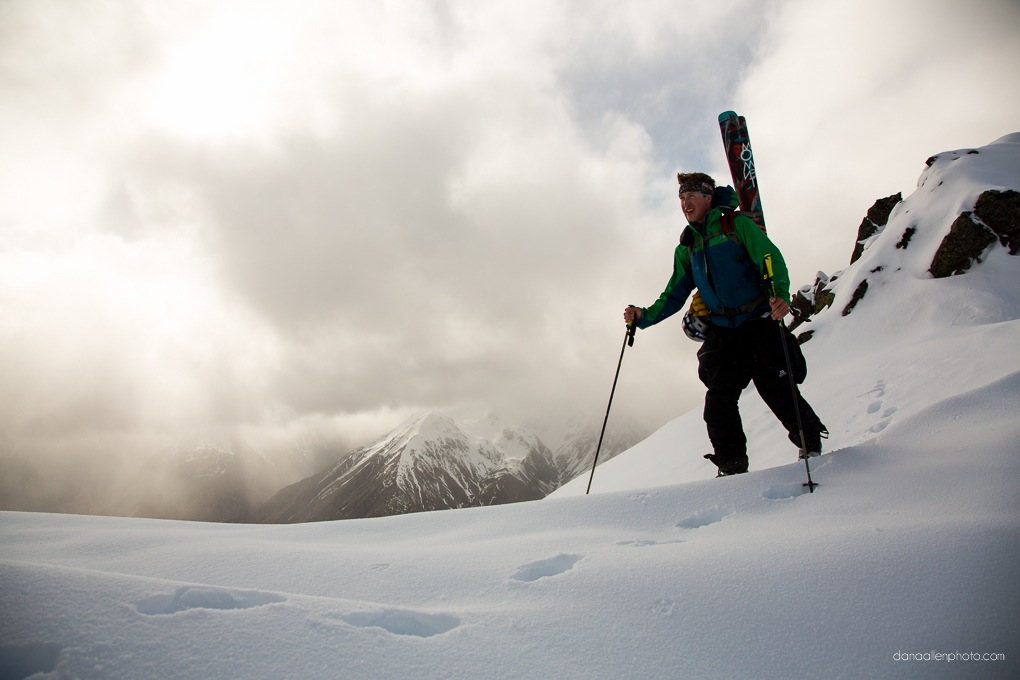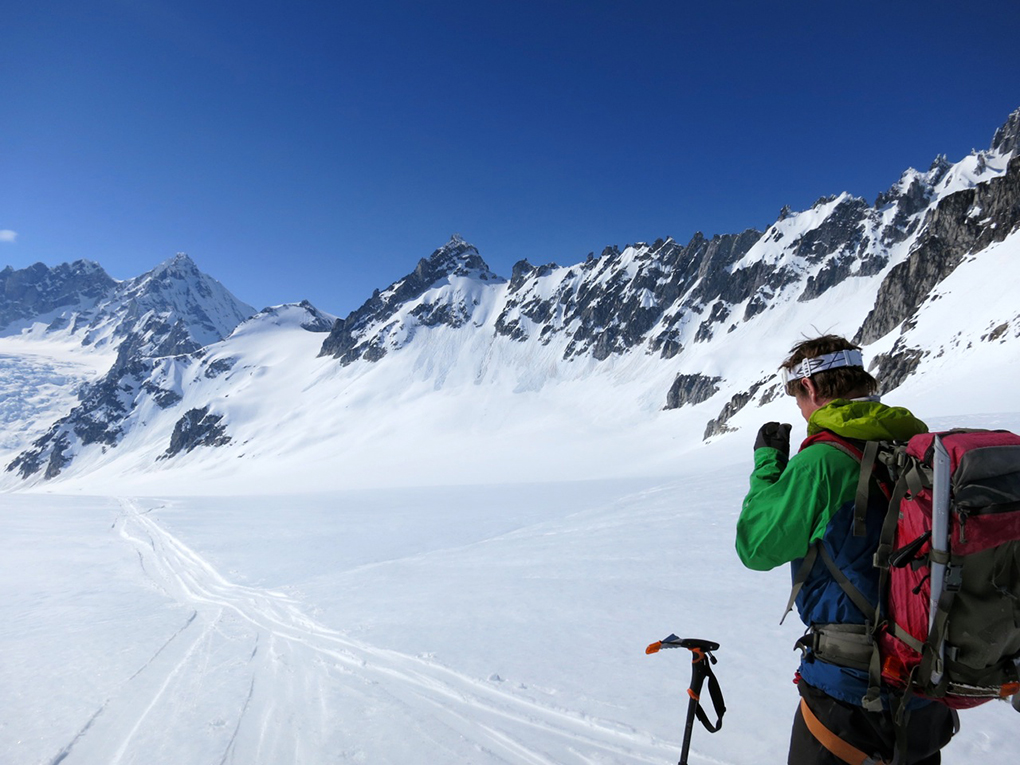Fabric – Gore-Tex Active Explained (Don’t Skip This Part)
The Firefox is made with Gore-Tex Active, a waterproof/breathable membrane “built for extreme breathability…ideal for highly aerobic, done-in-a-day activities.” The main body of the Firefox is covered with a light, 20-denier face fabric, while the arms and shoulders use a slightly more durable (but still quite light) 30-denier face fabric.
Gore’s Active Shell is made to be more breathable than traditional Gore-Tex by utilizing a high-temperature/high-pressure process that physically intertwines the fabric’s tricot liner into the PU laminate which protects its waterproof membrane.
(If you want to read a more in-depth explanation of the physics involved in waterproof/breathable membranes and how Gore Active compares to Gore Pro and other fabrics, read Sam Shaheen’s Outerwear 101 and 201 articles.)
And as with any of Gore’s waterproof/breathable fabrics, Gore mandates that every piece made with Active meets strict design requirements. Specifically, Gore requires that any jacket made with Active must weigh less than 13 ounces, which the Firefox does. This helps to assure that jackets made with Gore Active will exhibit the particular strengths of the fabric. But it also means that Gore Active jackets—while waterproof and highly breathable—are better suited for certain types of activities than Gore Pro.
Now I’ll get to the performance of the Firefox, which should help to clarify what I mean here.
Breathability (Mountain Equipment Firefox vs. Arc’teryx Rush vs. Norrona Lofoten Active)
When compared back-to-back against the Arc’teryx Rush (made with Gore Pro), the Mountain Equipment Firefox was the more breathable shell.
This seems to have to do (at least in part) with the design elements of the Firefox, including its face fabric which is much lighter than that used on the Rush (the Rush uses an 80-denier fabric on the arms and shoulders, and 40-denier on the torso). The Firefox’s mesh-backed pockets are also highly breathable when opened, and the pit-zips can be opened for full-on venting.

The Firefox did great while I hiked up windy ridges around Craigieburn and Mt Olympus, New Zealand, and continued to impress me as a jacket perfectly suitable for high-exertion days in wet or windy conditions.
When conditions are mild but decidedly damp, the most useful piece of clothing I own is still my Patagonia Houdini jacket. It cuts the wind and precip well for its weight, and is still very breathable so that I can skin, hike, or ride in it all day when conditions are a little wet.
I had hoped that a highly breathable shell such as the Firefox could negate the need for an ultra-light shell like the Houdini, but for me, the Houdini still ends up in the pack for big days out.
That said, if I’m going out for a high-output day in the mountains and there’s any wet snow, more than light rain, or heavy wind in the forecast, I’m always happy to have the Firefox. It’s highly breathable in its own right, and provides a great barrier against the elements—unlike the Houdini.
Waterproofing
I’ve spent a lot of days skiing in the Firefox, but I spend most of my summer living on Kodiak, a small, rocky island in the middle of the North Pacific off of the coast of mainland Alaska. Storms hit Kodiak frequently and intensely, and I don’t know of a better place to test waterproof / breathable gear.
All in all, the Firefox has served me very well. I’ve worn it smashing down muddy, downhill shuttle runs on my bike, swinging my two-hander for silvers and kings on the coast in breaking surf, and hanging out on the beach waiting for waves in the middle of a windy deluge. I’ve even done some respectable Alaskan bushwhacking in it. Through it all, I stayed as dry in the Firefox as any other shell I’ve used, including the Arc’teryx Rush.
I should note that I have not retreated the DWR (durable water repellant coating) on the Firefox, but I have washed and dried it a couple times, which usually helps renew DWR treatments.
Durability of the Firefox (Gore Active jackets vs. Gore Pro jackets) – Updated
In over 80 days of testing, I have not caused any significant damage to my Firefox jacket, and I’m typically pretty hard on fabric and zippers.
I am always suspicious of the coil-type zippers (like the Firefox’s) compared to molded zippers that, in my experience, are more durable and offer better weatherproofing. But so far, the front coil zipper on the Firefox hasn’t disappointed. I’ve only found a tiny stain of water on my baselayer during bike rides, but that could have been from water dripping down through the collar.

As for the Firefox’s face fabric, I’ve climbed through plenty of wet alder in the jacket, shouldered skis without hesitation, and there’s no damage on the jacket to show for it. The 30-denier fabric on the sleeves also got an especially nice workout while I was learning to use the rope tow systems at the NZ club fields, but again, they sustained no significant damage.
With all of that said, I still think a shell like the Arc’teryx Rush, that has a significantly thicker Gore-Pro membrane and a heavier, stiffer, 80-denier face fabric, is probably more appropriate than the Firefox for highly-abrasive activities. For example, if I’m planning to be skiing through a lot of tight, brushy trees (like those in Japan), riding a snowmachine often, or doing a lot of heli-skiing, I’d prefer wearing a jacket with Gore Pro (since it will have a thicker face fabric) that will stand up better to that kind of abuse over time.
Plus, if you’re looking for a jacket that has a lot of features (multiple large, zippered pockets, internal mesh pockets, etc), such features add weight to a jacket, so they don’t tend to appear on thinner jackets that use Gore Active.
In this way the Arc’teryx Rush is a bit more robust and more skiing-focused, while the Firefox put more emphasis on general packability and breathability with fewer features.
Bottom Line
For big days of mechanized skiing, or touring days where I might encounter a lot of deep snow, I might choose a heavier, ski-specific shell over the Mountain Equipment Firefox.
But outside of the deepest powder days of the season, the Firefox finds way into my pack more than any other shell. And for multi-day wilderness trips in Alaska during the summer, the Firefox is my first choice.

Paul, Can you comment on the overall quality differences between these mtn equipment pieces and comparable arcteryx items?
Hi Blister.
Very interesting review and comparison! I saw you mentioned the Sweet Protection Supernaut jacket in the fit section of this review. Is this a jacket which you are reviewing or have had much time in as I have recently had my eye on it so would be interested in hearing more about it!
Many thanks,
Jamie
Thanks for the review, Blister!
I’ve skied in the backcountry with this jacket for 10 days, and I’ve used it while resort skiing and snow shoveling too.
The days have ranged from freezing rain in Whistler to heavy snow in Japan.
I’d affirm that this jacket is super packable, and a great storm shell for BC skiing.
However, I’ve found a couple small caveats with the piece.
First, the main zip and pit zippers are quite tiny and hard to reach with gloves on.
Second, I’ve already put holes in the sleeves due to the very soft Gore fabric.
Third, the velcro on the wrist cuffs started to pull out after about a week’s use.
My verdict: use it for ski touring and rain gear, but not much else.